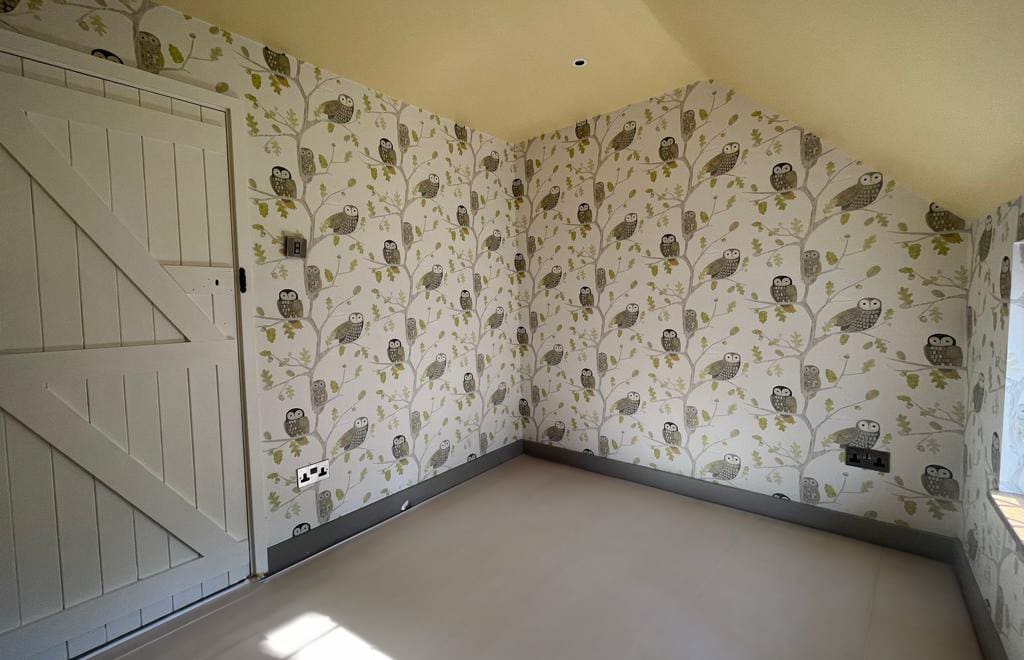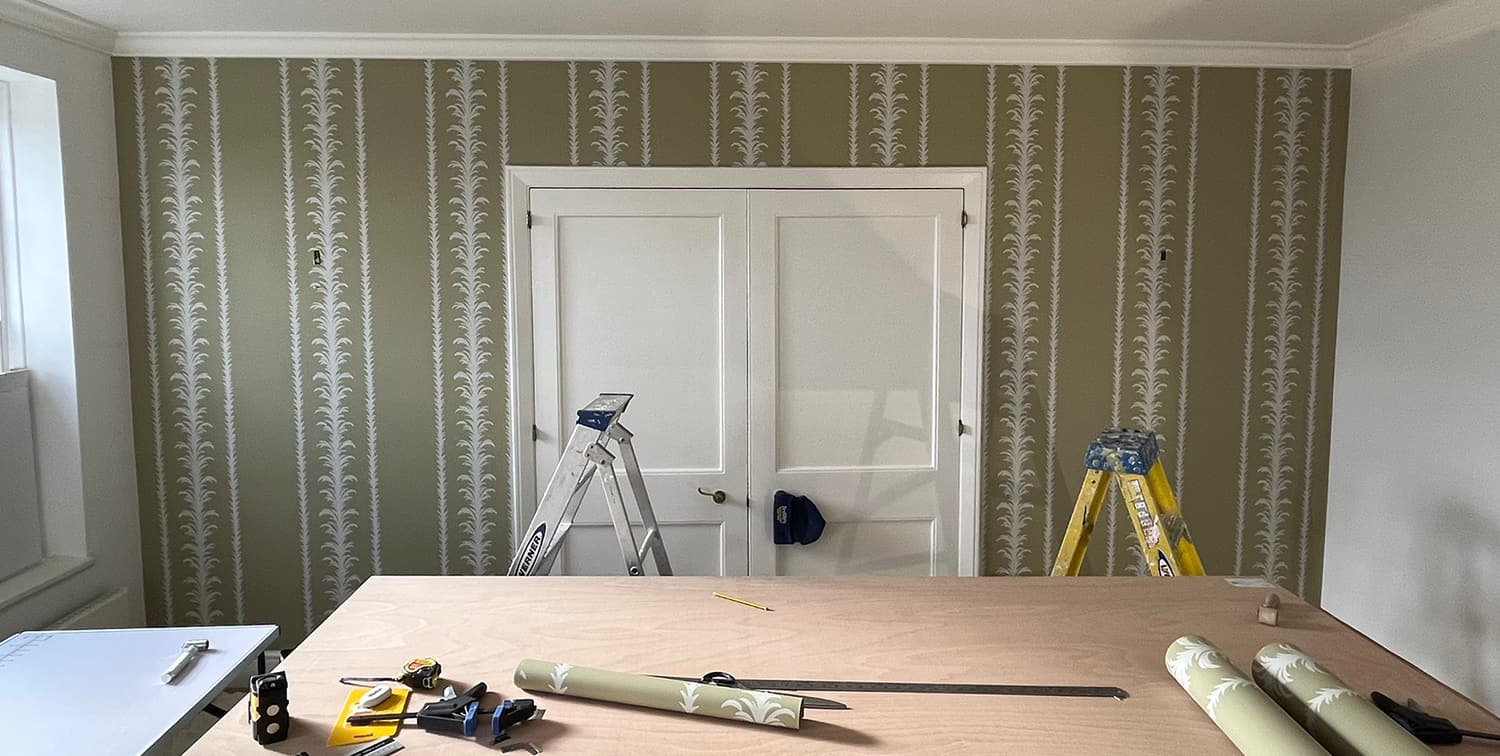Wallpaper can add character, warmth, and a unique touch to any room, making it a popular choice for both residential and commercial spaces. However, maintaining its beauty requires regular care and attention. Knowing how to clean wallpaper and maintain it properly is crucial to ensure its longevity.
So, how do you wash wallpaper? Read on for information on the best practices for keeping your wallpaper looking fresh and vibrant for years to come.
Types of Wallpaper: Washable vs. Non-Washable
Before diving into cleaning techniques, it’s essential to understand the type of wallpaper you have. Different wallpapers require different care, and missteps can lead to permanent damage.
Types of Washable Wallpaper
- Vinyl Wallpaper: Extremely durable and water-resistant, vinyl wallpaper is one of the easiest to clean. It’s a great choice for high-traffic areas such as kitchens, bathrooms and hallways.
- Non-Woven Wallpaper: Made from a blend of natural and synthetic fibres, non-woven wallpaper is tear-resistant and can be lightly cleaned with water and mild soap.
- PVC Wallpaper: A wipe clean wallpaper known for its durability, PVC wallpaper can be easily wiped down with a damp cloth, making it ideal for spaces prone to spills and stains.
Types of Non-Washable Wallpaper
- Paper Wallpaper: More delicate than its washable counterparts, paper wallpaper should be cleaned with care. Water can cause it to warp, so it’s best to avoid any wet cleaning methods.
- Textile Wallpaper: Made from natural or synthetic fabrics, textile wallpaper is sensitive to moisture. Spot cleaning with a dry cloth is recommended.
- Grasscloth Wallpaper: This natural fibre wallpaper is beautiful but fragile. It’s highly absorbent, so cleaning should be limited to gentle dusting.
- Foil Wallpaper: With a shiny, reflective surface, foil wallpaper is prone to scratches and requires very gentle cleaning, typically with a dry, soft cloth.

What Does Each Wallpaper Cleaning Symbols Mean?
Before you clean wallpaper, you should first take the time to understand what the different cleaning symbols mean. This is a vital step that’ll ensure you’re providing the wallpaper with the appropriate maintenance. Here are some common symbols you might encounter:
- Single Wavy Line (Spongeable): Only a dry sponge should be used to clean the wallpaper and has the lowest washability rating.
- Double Wavy Line (Washable): The second lowest washability rating and can be cleaned with a damp sponge.
- Tripple Wavy Line (Extra-Washable): More resilient to cleaning and moisture and can be cleaned using soap and water.
- Brush and Single Wavy Line (Scrubbable): Can be scrubbed with a brush using water and a mild soap.
World of Wallpaper have created a comprehensive wallpaper symbols guide that explains these symbols and others in depth. There are various symbols to be aware of and Decorating Centre Online is another great source if you’re looking for wallpaper symbols explained in detail.

Maintenance Tips to Keep Wallpaper Clean
Dust Regularly
Dusting is the first line of defence in maintaining your wallpaper. Regular dusting prevents dirt buildup, which can dull the appearance of your wallpaper over time.
How to Dust Wallpaper:
- Use a soft, dry cloth, a microfibre duster, or a vacuum cleaner with a brush attachment to gently remove dust from the wallpaper’s surface.
- Pay extra attention to corners and edges where dust tends to accumulate.
- If your wallpaper has a texture, use a soft brush to avoid damaging the surface.
Minimise Humidity and Mould
Humidity can wreak havoc on wallpaper, particularly in bathrooms, kitchens, or basements where moisture levels are higher. Over time, excessive moisture can lead to mould growth, which not only damages the wallpaper but also poses health risks.
How to Prevent Mould:
- Use a dehumidifier to maintain a consistent humidity level in rooms with wallpaper and ensure proper ventilation in areas prone to moisture.
- Regularly inspect wallpaper in high-humidity areas for early signs of mould.
- If you do spot mould, it’s crucial to act quickly.
How to Clean Mould Off Wallpaper:
- To remove mould from wallpaper, mix a solution of water and white vinegar, lightly dampen a cloth, and gently dab the affected area.
- Be sure to dry the spot immediately after cleaning.
- Once dry, repeat the process if there are still signs of mould.
Protect Your Wallpaper from Sunlight
Direct sunlight can cause wallpaper to fade, leading to uneven coloration over time. While some degree of fading is inevitable, there are steps you can take to minimise its impact.
Sunlight Protection Tips:
- Use curtains, blinds, or UV window film to block or filter sunlight when the room is not being used.
- Rearrange furniture periodically to prevent consistent exposure to sunlight on the same area of wallpaper.
- Consider using wallpaper with built-in UV protection for rooms that receive a lot of sunlight.
Clean Wallpaper Stains and Spots Promptly
Accidents happen, and when they do, cleaning wallpaper stains and spots as soon as possible is important to prevent them from setting in.
Removing Wallpaper Scuff Marks:
- Scuff marks can often be removed with a simple eraser sponge.
- Gently rub the eraser over the mark, being careful not to apply too much pressure.
- Repeat the process until the scuff mark has disappeared.
How to Clean Grease Off Wallpaper:
- Start by blotting the area with a paper towel to absorb as much grease as possible.
- Then, lightly sprinkle cornflour or baking soda over the stain to draw out the remaining oil.
- After about 15 minutes, gently brush away the powder.
- If needed, use a small amount of dish soap on a damp cloth to carefully dab the area.

How to Clean Washable Wallpaper
Cleaning washable wallpaper is a straightforward process, but it’s important to use the right materials and techniques to avoid damage.
Materials Needed:
- Soft sponge or cloth
- Mild soap
- Bucket of warm water
- Dry towel
Steps:
- Dust the Wallpaper: Before washing, make sure to remove any dust using a dry cloth or vacuum.
- Prepare the Cleaning Solution: Mix a small amount of mild soap with warm water in a bucket.
- Test a Small Area: Always test the cleaning solution on a small, inconspicuous area of the wallpaper first to ensure it doesn’t cause discoloration or damage.
- Gently Clean the Surface: Dip the sponge or cloth into the soapy water, wring it out well, and gently wipe the wallpaper in a circular motion.
- Rinse with Clean Water: After cleaning, rinse the sponge in clean water and wipe the wallpaper again to remove any soap residue.
- Dry the Wallpaper: Use a dry towel to blot the wallpaper, ensuring no water is left behind to seep into the material.
How to Clean Non-Washable Wallpaper
Non-washable wallpaper requires more delicate care, as moisture can cause irreversible damage.
Materials Needed:
- Soft, dry cloth
- Dry cleaning sponge
- Eraser sponge (for stubborn marks)
Steps:
- Dust the Wallpaper: Use a soft cloth or vacuum to remove dust.
- Use a Dry Cleaning Sponge: For more thorough cleaning, use a dry cleaning sponge, which is specifically designed for non-washable surfaces. Gently rub the sponge across the wallpaper, focusing on any dirty spots.
- Erase Stubborn Marks: For any remaining stains or marks, lightly use an eraser sponge. Be cautious not to press too hard, as this could damage the wallpaper.
- Inspect and Repeat: Check the wallpaper for any missed spots and repeat the process if necessary.
Conclusion
Maintaining the beauty of your wallpaper doesn’t have to be a daunting task. With regular dusting, prompt attention to stains, and appropriate cleaning techniques, you can keep your wallpaper looking fresh for years to come. Whether you have washable or non-washable wallpaper, understanding how to care for it is key to its longevity.
For those considering new wallpaper or needing expert assistance with wallpaper installation, Marshels offers professional wallpaper hanging services to ensure a flawless finish. Contact us on enquiry@marshels.co.uk, 01252 377714, or request a free quote for your wallpaper hanging project by filling out our contact form.








